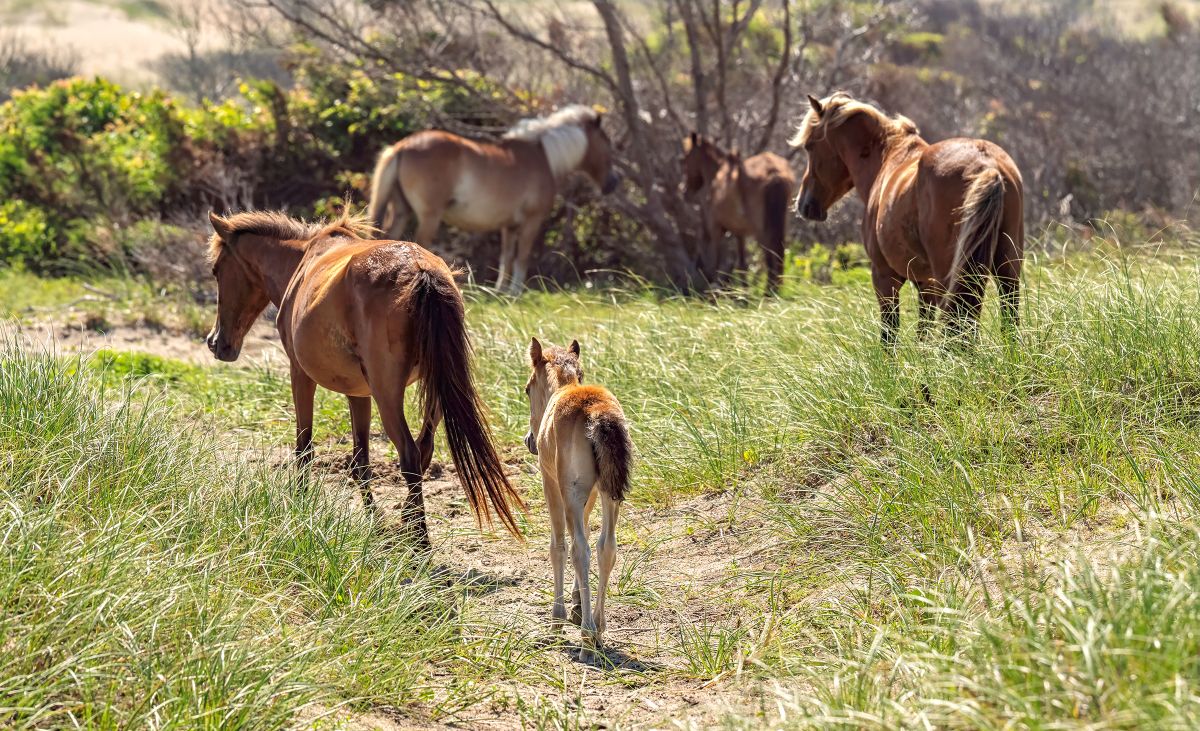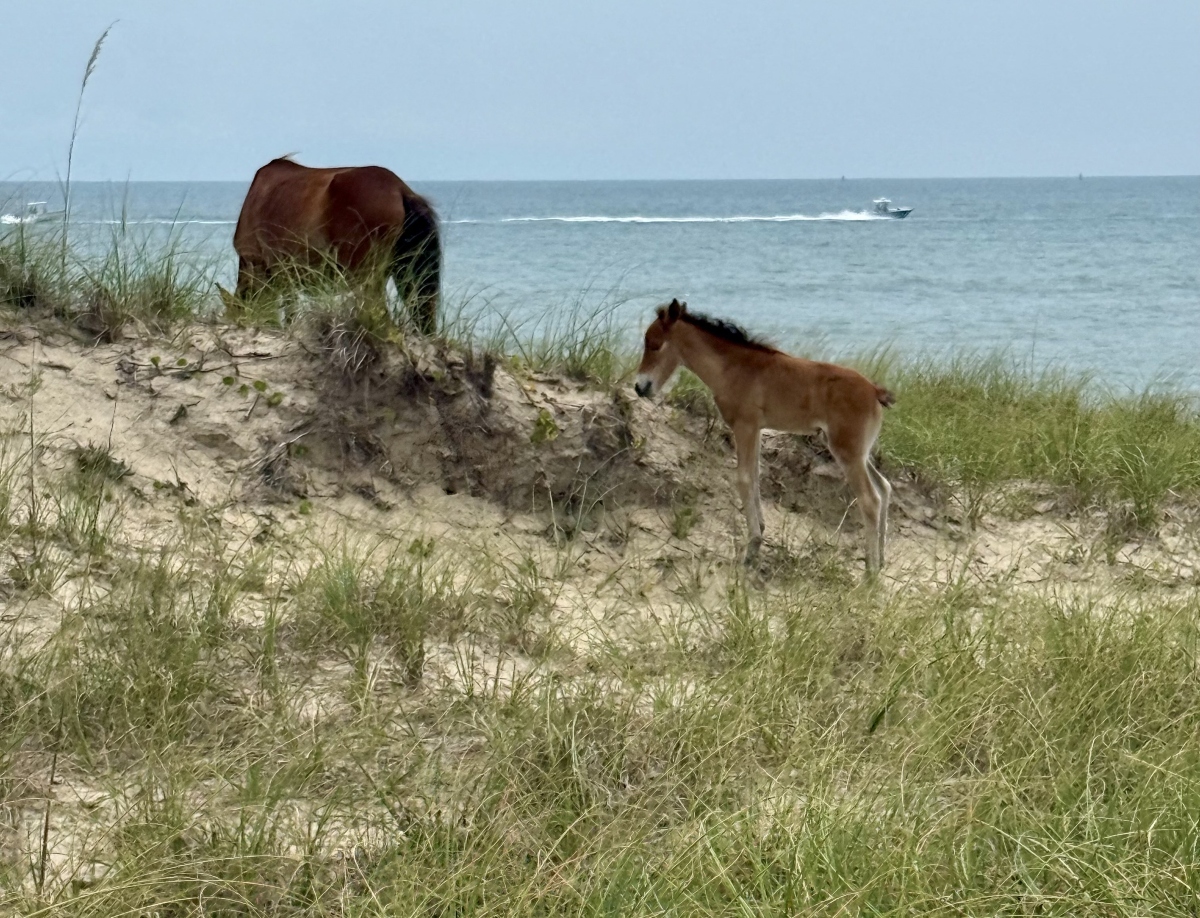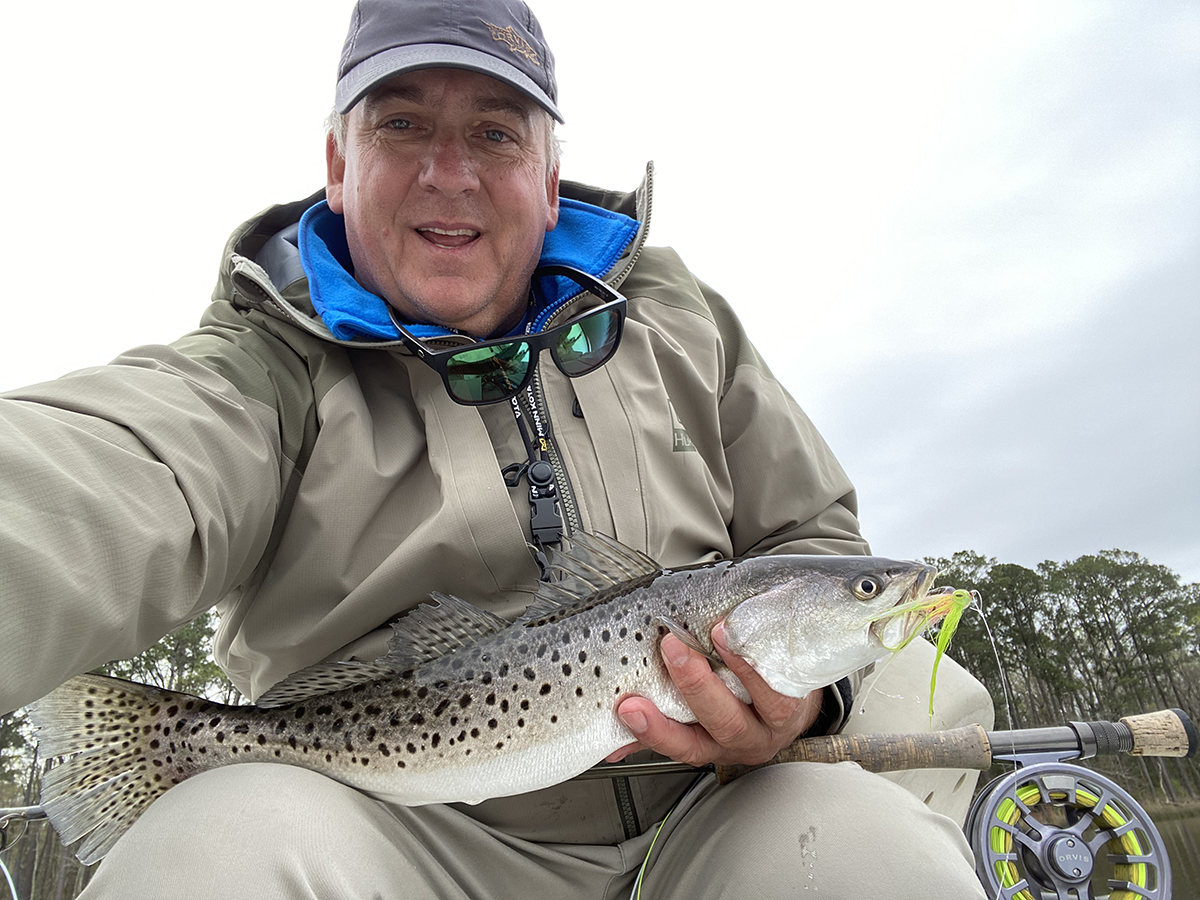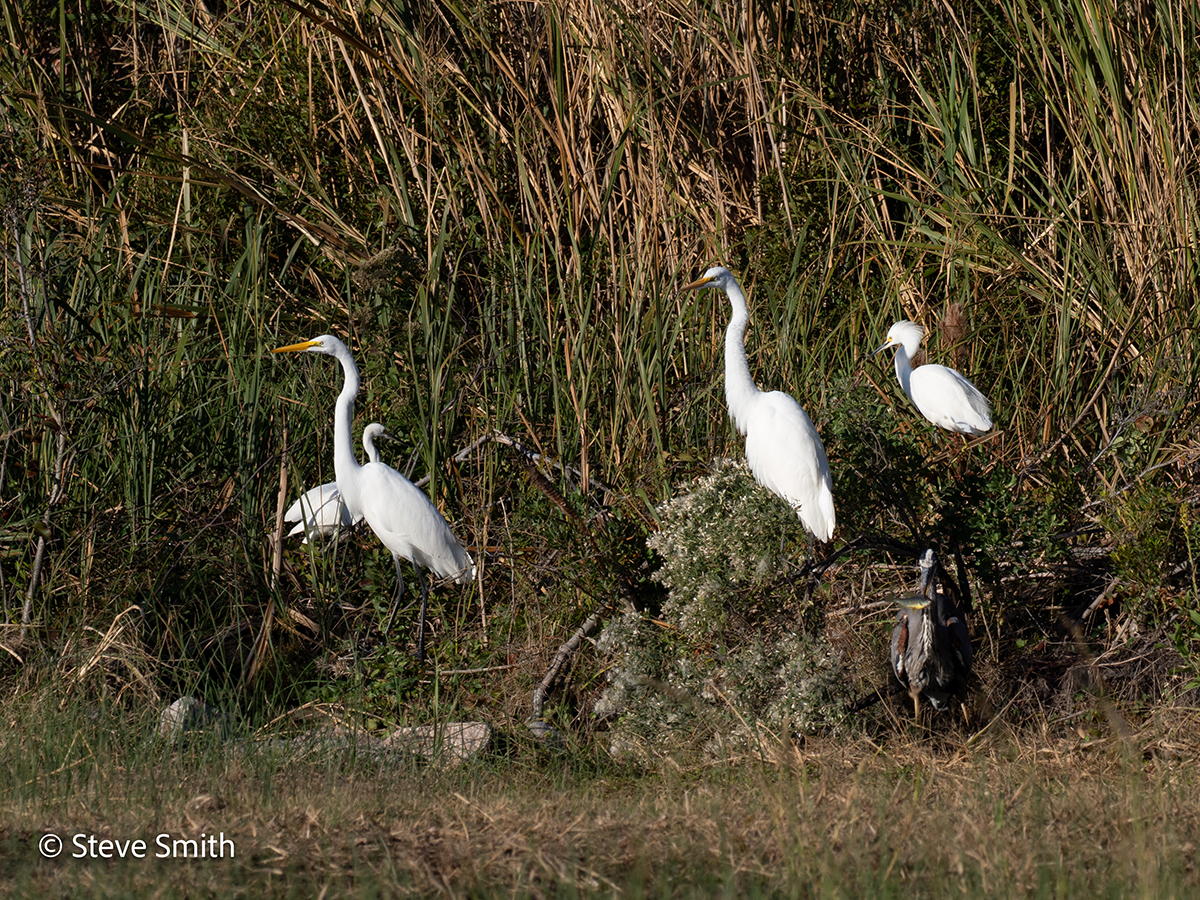
A group of volunteers spent peak visitor season this year under the blistering sun and swarmed by thick clouds of flying insects, all to make sure the wild horses, including the newborn foals, inhabiting Cape Lookout National Seashore and Rachel Carson Reserve were undisturbed by the thousands who make their way to the barrier islands that are only accessible by boat.
The volunteers are part of the Pony Patrol program, which trains the “Pony Patrollers,” as they’re called, to share with visitors how to safely observe the two herds. One herd is on Shackleford Banks, the national seashore’s southernmost island, and the other is on the reserve site that is across Taylors Creek from downtown Beaufort.
Supporter Spotlight
The National Park Service, Foundation for Shackleford Horses and reserve staff organize the outreach effort that just wrapped up its third year. The foundation is the federally designated co-manager with the park service of the herd.
Rich Rehm, a volunteer who leads the program for Cape Lookout, explained that the goal of Pony Patrol for the park service is twofold. First is to make sure guests on Shackleford Island stay at least 50 feet from the horses and keep their dogs leashed. Second, as representatives of the National Park Service, is to answer questions visitors may have about the horses, the island, or the seashore.
Paula Gillikin, stewardship coordinator for the 10 reserve sites, has been the longtime manager for the herd at Rachel Carson Reserve, one of 10 protected sites along the coast managed by the North Carolina Coastal Reserve and National Estuarine Research Reserve, under North Carolina Department of Environmental Quality.

“The Pony Patrol plays a vital role in supporting the Rachel Carson Reserve and our partners by helping us educate the public about the wild horse population that makes the reserve such a unique part of North Carolina’s coastal heritage,” Gillikin said. “When the public understands what the horses need to survive and be healthy, they are more likely to give the horses the space they need to thrive. This understanding also keeps our visitors safe.”
Foundation President Margaret Poindexter told Coastal Review that the 2025 season had been the largest “and undoubtedly our most successful,” despite its “very difficult start.”
Supporter Spotlight
What made 2025 special, she continued, was the determination and resolve of the close to 50 volunteers.
The rocky start began when the first foal of the year from either herd was born at the Rachel Carson Reserve in early May, Poindexter said.
“Her presence was immediately known — lots of eyeballs in Beaufort are constantly on that herd. Just a few days after her birth, and within days of the Pony Patrol season launching, a group of visitors got too close to the foal, the anxious stallion gathered up his mare to get away from them, and the foal was stranded on the oyster rocks unable to keep up with its mama,” she explained.
Though the reserve staff was able to intervene and reunite the two, the Pony Patrollers “were very disappointed that something so potentially tragic could happen so early into the season, before the real rush of visitors even started,” Poindexter said.
Then, on the Saturday of Memorial Day weekend, a newborn foal was found alone on the east end of Shackleford, on the oceanside. The foundation “made the difficult decision to remove it in order to save its life. Again, the Pony Patrollers were discouraged, afraid that perhaps human intervention had caused the foal to be separated from its mother,” she continued.
Another foal on Shackleford was separated from its mother 10 days later, found in the mud on the sound side, likely as the result of a stallion fight. It too was removed to save its life, Poindexter said.
Volunteers Margo Hickman and Laura Palazzolo, both Carteret County residents, agreed it was particularly heartbreaking to see the foals removed from the island earlier this summer. Hickman said it was uncertain if they would survive.
“’The Americas’ TV episode about Shackleford was beautiful, but it drew a lot of attention — and with that came more pressure on the horses,” Palazzolo said. The first episode, “The Atlantic Coast,” of the NBC series dated Feb. 23 began with the wild horses at Cape Lookout.

“There were multiple incidents of visitors getting too close, trying to take selfies, or even attempting to pet the ponies,” Palazzolo explained. “We can’t say for sure why two foals were abandoned on the east end, but human interference could certainly have played a part.”
Poindexter continued that “Shortly after those incidents, a filly was born on the west end of Shackleford, in an area that receives significant visitation because of its close proximity to the ferry drop and the crossover to the beach. The Pony Patrollers committed themselves to ensuring the safety and survival of this little girl.”
The volunteers scheduled regular tours in the area around the pair and reported to each other after their shift about the whereabouts and well-being of the foal and her mother. “They intercepted numerous visitors who were curious about her, moving them away from her so as not to interfere with her nursing and nap times, but sharing insider information about her and her harem to create a unique and enhanced visitor experience,” Poindexter said.
Some of the volunteers that have been with the program since the first season, including retirees Hickman and Deb Walker, have been captivated by the filly.
Walker, who grew up in Newport and returned after retiring in 2015 from several decades as an educator in Mississippi, said a major highlight for her this summer was the newborn filly.
Hickman called the filly’s birth “the icing on the cake” for her. “We all became part of her family as her honorary aunts. We weathered heat and humidity and some god-awful mosquitoes daily to check on her.”

Fellow Pony Patroller Cindy K. Smith, who began volunteering in 2024, was the first of the group to spot the filly.
Smith, a Straits resident, said she was fortunate to be leading a tour that day in June when she spotted the foal shortly after birth. “Her little legs wobbled to steady herself against her Mama.”
Smith is photographer, naturalist and guide who has been visiting Shackleford and Rachael Carson for 30-plus years and joined Pony Patrol because, like so many others, she has a “fascination with the ‘ponies.’”
Smith said once realized the foal was a newborn, she began calling seashore staff and other patrollers.
“We were all elated,” Smith continued, adding that knowing that the Fourth of July week, and the associated influx of visitors, was near, the volunteers knew extra precautions would be needed to keep her safe and at a distance from human interaction.
The volunteers were given guidance from seashore and foundation staff to developed a plan to quietly watch from afar, Palazzolo said, adding they always kept a respectful distance. “At least one Patroller was stationed on the dunes, watching and ready to gently intervene if visitors wandered too close.”

Smith reiterated that the volunteers “went over and above for this little girl, perching on dunes, hiding behind bushes or whatever it took to make sure she would not be approached. Individuals went out on their own and watched over her even when it was not a shift. I think this camaraderie bonded us in a way that made each of us better and as a whole, a more cohesive unit.”
The foal is thriving now, Palazzolo explained, and along the way, “visitors got to experience something really special. We’d share what we’d learned from our reports — her habits, her routine — and people would sit quietly to watch. We’d tell them, ‘If you stay back and give her space, you’ll see her nurse, nap, or maybe even get the zoomies.’ It became this magical moment of connection — respectful and joyful all at once.”
How Pony Patrol began
Poindexter explained that the first year in 2023 was truly a pilot, and began with around 30 participants.
“We only sent volunteers to Shackleford that first season. Rich Rehm, one of the seasoned volunteers at Cape Lookout National Seashore, stepped up and offered to be the program coordinator. Truly, without his willingness to fill that role, the program likely would never have gotten off the ground,” Poindexter said.
Rehm retired as an environmental consultant in the Research Triangle Park area and moved to in 2016 to Merrimon with his wife. He began volunteering with the seashore in 2017.
When Rehm was asked in 2019 to coordinate the program for the National Park Service, he said he passed on the opportunity. Then, the program was put on hold because of the COVID-19 pandemic. In 2022, he decided he would take up the role.

After that first year in 2023, the seashore “was pleased with the success of the program and we expanded the program to include Rachel Carson Reserve,” Rehm said. “In 2025, we expanded the program again to include the east end of Shackleford Island.”
Though the 2025 season wrapped up in late September, a call for volunteers will likely go out in the coming months from both the National Park Service and Rachel Carson Reserve ahead of the 2026 season. Gillikin, with the reserve, said Pony Patrol applications for both herds will likely be launched in January or February.
Poindexter said that those interested in joining the Pony Patrol should know that conditions are rough. “Walking over dunes, in sand, through mud and marsh, often in extreme heat and humidity, while being besieged by mosquitoes,” she said.
Despite the challenges like the heat, the bugs, the mud, and the occasional rude visitor, Palazzolo said the horses make it all worth it.
“There’s nothing like standing on those dunes, watching them go about their day. It reminds you that wildness still exists — and that it’s fragile,” she said. “I’m looking forward to checking on her this winter — and jumping right back in next summer.”
Rehm added, “If you can put up with the heat, the humidity, the bugs, and the storms by all means you should volunteer.”
Coastal Review will not publish Tuesday in observation of Veterans Day.







